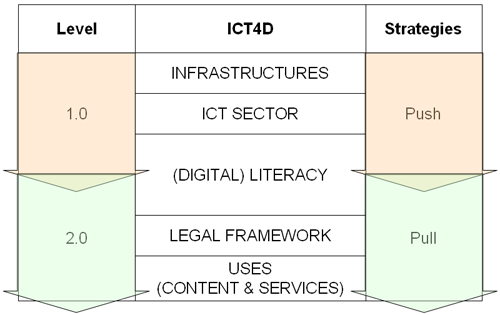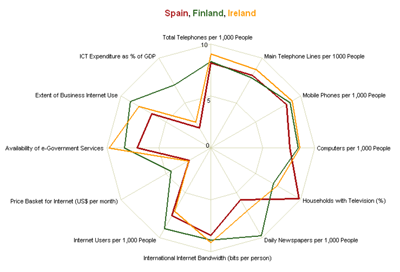In a seminar I imparted in January — Fostering the Information Society for Development in the Web 2.0 framework: from push to pull strategies — the case of Spain — I suggested that the most developed countries had reached sort of a threshold of installed infrastructures. Of course, this threshold could be pushed up and more infrastructures (or better and cheaper ones) could be installed, but the development of the Information Society would barely rely on that.
According to the data available, I wondered whether the solution might be shifting from push to pull strategies, parallel to the shift that we’ve been living in the web landscape towards the so-called Web 2.0.
This is the chart I then presented:
Now, with data from the World Bank we can draw another picture that seems to back my ideas — or, at least, I’ll make it fit to them.
Finland and Ireland have usually been examples of best practices in benefiting from ICTs to foster their respective economies and welfare. Even with different cultural frameworks, development models and economic approaches, they are both doing well and are a recurrent example. Spain, on the other hand, is the typical example of the “wannabe”: is doing quite well at the economic level, but the development level of its Information Society seem never to take off.
Let’s compare their respective indicators:
The right side of the chart — including the indicators at the top and bottom — could be considered as infrastructures. All three countries do more or less equally, though Ireland performs sligtly better and the availability of bandwidth is worse in Spain. We could consider also “infrastructures” (human capital) TVs and newpapers, and I guess the inequalities and preferences of each country are quite correlated with their respective educational levels: more newpapers, better education; more TVs, worse education.
But the interesting part is the left part of the chart.
First difference is intensity of use, were Finland does better, though it has worse prices, so affordability, in these cases, does not seem to be the explanation.
What about the other three indicators? Investment (one dare think of R&D to create content and services), intensity of use at businesses (maybe related with possibilities of e-commerce, e-business, B2B, B2C, etc.) and availability of e-Government Services. In other words: demand generating initiatives.
So, it seems that with similar infrastructures, it is demand driven strategies the ones that seem to foster the development of the Information Society. The analysis is quite simple and is not flawless, but all evidences seem to be slowly converging towards the same conclusion.
If you need to cite this article in a formal way (i.e. for bibliographical purposes) I dare suggest:
Peña-López, I. (2008) “Development of the Information Society: After Infrastructures, Pull Strategies” In ICTlogy,
#56, May 2008. Barcelona: ICTlogy.
Retrieved month dd, yyyy from
https://ictlogy.net/review/?p=735
Previous post: Announcement: 4th Internet, Law and Politics Congress
 RSS feed for comments on this post.
TrackBack URI
RSS feed for comments on this post.
TrackBack URI



